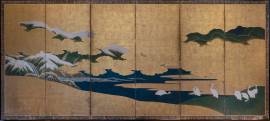Rinpa SchoolEarly Edo period (1615-1867), 17th centurySix-fold screen; gold ground.169 x 376 cm The term ‘Rinpa’ is an amalgamation between the last syllable from ‘Kōrin’, name of the mayor exponent of this artistic movement, and the word pa, literally “school” or “group”. However, it is to say that this name was given only later, in the 17th century, when Kōrin (1658 – 1716) further developed the school’s style. Concretely it refers to the broadly teaching of Kōrin masters. The first promoters of the Rinpa style are identified...
WORKS FOR SALE
Edo Period (1615-1867), 19th centurySealed by the artist in red ink, 138 by 304 cmThis pair of screens belongs to a genre of lyrical paintings of flowers, grasses, and other plants that flourished around the middle of the seventeenth century and became a specialty of the Sôtatsu studio. The use of a rather complex composition of clusters of flowers and the puddling of ink was initiated by Tawaraya Sôtatsu, the founder of the Rimpa school, who was active from 1600 until 1642. The screens are abstract and decorative but there is, at the same time, a keen sense of naturalism not only in the...
SCHOOLRinpa SchoolDATEEdo Period (1615-1867),19th centuryMEDIUMInk, gold color on paperDIMENSIONS170.5 by 370 cm The screen shows Chrysanthemums and daisies of various sizes close to a fence. The composition is executed with a rich green foliage over a gold background and the only external element is the plain fence, designed in pale gold.The leaves are colored using the tarashikomi, a classic Rinpa technique in which pale black ink or a color is brushed onto an area of a painting and then either darker ink, or the same or a contrasting color, is dropped into the first before it...
Copyright © 2016 - giuseppe piva - VAT: 05104180962










